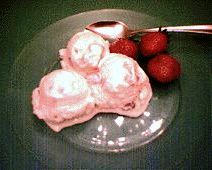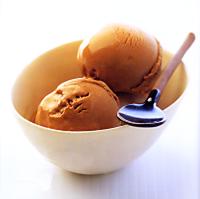The history
of ice cream began centuries ago....
There are rumours that Nero (Roman Emperor) and the ancient Chinese (via
Marco Polo) enjoyed an “ice-cream-like dessert”…these desserts, while
frozen, are not ice cream as we know it, but more like sorbet or
probably a snow-cone! Nero would have servants run to the mountains for
fresh snow and then race back (before it melted) to his palace where he
would enjoy the frozen treats topped with fresh fruits. Again, it’s not
the dairy treat we enjoy today, and further – it was something only
royalty enjoyed.
Ice cream as a dairy delight was probably “discovered” in the 1600’s.
The concept of flavoured ices evolved, but no one is sure how.
However it is a well known fact that Charles I of England, or rather,
his chef (either French or Italian) made ice cream a staple of the royal
table. Depending on which version you read, either the chef had a secret
recipe for ice cream and the king paid him a handsome reward to keep it
a secret, or the chef was threatened with death if he divulged the
recipe. Either way, once Charles I was beheaded in 1649, the chef
revealed the secret recipe. Soon nobility in Europe knew of, and enjoyed,
delicious ice creams.
The still-for-the-rich “iced creams” were widely known in the 18th
century on both sides of the Atlantic. Several recipes appear in a
French cookbook, “L’Art de Faire des Glacés”, and in the soon-to-be
United States, ice cream was also known.
Thomas Jefferson had a recipe for Vanilla ice cream, George Washington
paid almost $200 (a massive amount of money at the time) for a specific
recipe. Still, ice cream was restricted in quantity and popularity, due
to the enormous effort needed to make it.
The hand crank might have been fine for backyard picnics, but no one
considered ice cream making as an industry – until Jacob Fussell in
1851. The milk dealer was looking for a way to keep a steady demand for
his cream. He discovered that he could do so by turning it into ice
cream – and he could get twice the price! His Baltimore factory utilized
icehouses and a larger version of Johnson’s machine, and by the start of
the Civil War he had additional ice cream plants in New York,
Washington, and Boston. Ice cream still didn’t become a widespread
phenomenon until the 20th century, when advances in refrigeration and
power allowed severe increase in production.
For over a century, we have been enjoying ice cream on a cone. Whether
it's a waffle cone, a sugar cone or a wafer cone, what better way to
enjoy a double scoop of your favourite flavour?
The first ice cream cone was produced in 1896 by Italo Marchiony.
Marchiony, who emigrated from Italy in the late 1800s, invented his ice
cream cone in New York City. He was granted a patent in December 1903.
The first ice cream cone story…
Italo Marciony, emigrated to the United States in the late 1800s, and
although he lived in Hoboken, NJ for a time his fame resides solely in
New York City. He began his business selling his homemade lemon ice from
a single pushcart on Wall Street, but his business quickly grew into
many carts.
Although he was successful he still had a small problem that was causing
him to lose money. At the time, most ice cream from vendors was sold in
serving glasses called "penny licks" (because you'd lick the ice cream
from the glass, and it cost a penny to do so).
There was a major problem with sanitation (or the lack thereof), but
Marciony's problem was that many people would accidentally break the
glasses, or not so accidentally walk off with them.
His first solution was to make cone-like containers out of paper which
worked fine until he was hit with a stroke of genius. He came up with
the idea of making an edible container for his cool treat. So in 1896 he
began baking edible waffle cups with sloping sides and a flat bottom -
shaped like his serving glass - and it was an instant hit.
On September 22, 1903, he filed a patent application out of the city and
state of New York, and U.S. Patent No. 746971 was issued to him on
December 15, 1903.
Although Marchiony is credited with the invention of the cone, a similar
creation was independently introduced at the Saint Louis, Missouri in
1904 at the Louisiana Purchase Exposition, where the story goes that a
Syrian pastry maker, Ernst Hamwi who was selling zalabia, a crisp pastry
cooked in a hot folding waffle-patterned press, and dribbled with syrup,
came to the aid of a neighbouring ice cream vendor, perhaps Arnold
Fornachou or Charles Menches, who was running out of dishes, by rolling
a still-warm zalabia into a cone that could hold ice cream. However,
numerous men who sold pastries at the World's Fair claimed to have been
the inventor of the ice cream cone, citing a variety of inspirations.
After the fair the ice cream cone became popular in St. Louis and within
a few years, the ice cream cone was being sold nationwide. Hamwi's story
is largely based on a letter he wrote in 1928 to the Ice Cream Trade
Journal, long after he had established the Cornucopia Waffle Company,
which had grown into the Missouri Cone Company. Nationally, by that time,
the ice-cream cone industry was producing some 250 million cones a year.
Ice cream cone - A Business is born…
St. Louis, a foundry town, quickly capitalized on the cone's success.
Enterprising people invented special baking equipment for making the
World's Fair cornucopia cones.
Stephen Sullivan of Sullivan, Missouri, was one of the first known
independent operators in the ice cream cone business. In 1906, Sullivan
served ice cream cones (or cornucopias, as they were still called) at
the Modern Woodmen of America Frisco Log Rolling in Sullivan, Missouri.
At the same time, Hamwi was busy with the Cornucopia Waffle Company. In
1910, he founded the Missouri Cone Company, later known as the Western
Cone Company.
As the modern ice cream cone developed, two distinct types of cones
emerged. The rolled cone was a waffle, baked in a round shape and rolled
(first by hand, later mechanically) as soon as it came off the griddle.
In a few seconds, it hardened in the form of a crisp cone. The second
type of cone was molded either by pouring batter into a shell, inserting
a core on which the cone was baked, and then removing the core; or
pouring the batter into a mold, baking it and then splitting the mold so
the cone could be removed with little difficulty.
In the 1920s, the cone business expanded. Cone production in 1924
reached a record 245 million. Slight changes in automatic machinery have
led to the ice cream cone we know today. Now, millions of rolled cones
are turned out on machines that are capable of producing about 150,000
cones every 24 hours.
The idea of selling a frozen ice-cream cone had long been a dream of
ice-cream makers, but it wasn't until 1959 that Spica, an Italian
ice-cream manufacturer based in Naples conquered the problem of the
ice-cream making the cone go soggy. Spica invented a process, whereby
the inside of the waffle cone was insulated from the ice-cream by a
layer of oil, sugar and chocolate. Spica registered the name Cornetto (ice-cream)
in 1960. Initial sales were poor, but in 1976 Unilever bought out Spica
and began a mass-marketing campaign thought Europe. It is now one of the
most popular ice-creams in the world.



